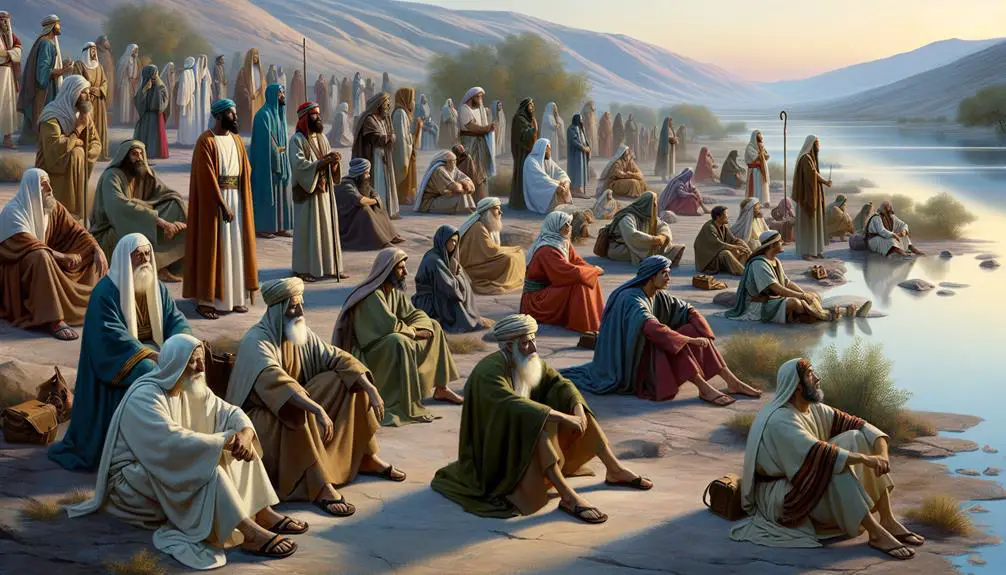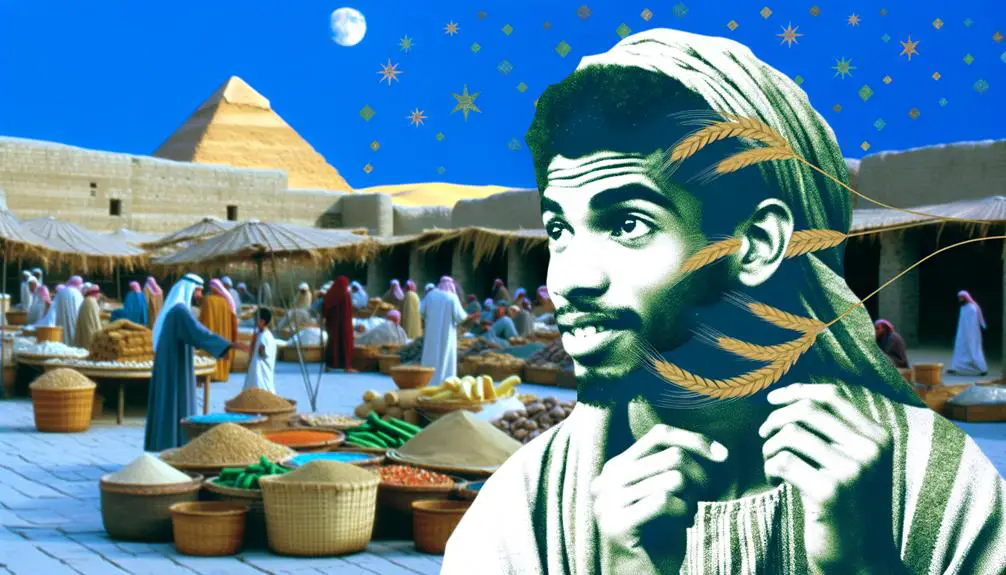Yearn to learn how biblical figures like Abraham and Hannah mastered patience? Discover the transformative power of waiting in their stories.

Examples of Waiting in the Bible
In the Bible, Abraham waited for a son, Joseph endured years in prison, and Hannah prayed tirelessly for a child. These stories, along with others, exemplify the virtue of patience and the profound outcomes of waiting with faith.
As you explore these narratives, you'll uncover not just the struggles and triumphs of biblical figures but also timeless lessons on perseverance and trust. The journey through these tales may inspire you to reflect on your own experiences of waiting and what they can teach about faith, patience, and resilience.
Curiosity piqued? There's much more to uncover about the power and purpose behind waiting in these ancient texts.
Key Takeaways
- Biblical narratives showcase that waiting on God often involves transformative faith development and character growth.
- Patience in waiting is portrayed as an active, faith-filled state leading to deeper spiritual insights and fulfillment of divine promises.
- The stories of individuals waiting in the Bible reflect a deep trust in God's timing, challenging societal expectations and personal spirituality.
- Waiting is a theme that underscores the importance of covenant relationships and collective identity within the context of divine care and promises.
Abraham and Sarah's Journey

In exploring the theme of waiting within the biblical narrative, one can't overlook the profound journey of Abraham and Sarah, a story that encapsulates patience and faith amidst uncertainty. Their narrative stands as a seminal example of how divine timing often diverges from human expectations, testing the bounds of belief and obedience.
You'll find that the essence of their story revolves around the tension between the promise made and the time it took for that promise to be fulfilled. God's assurance to Abraham that he'd father a great nation seems, at first glance, straightforward. Yet, the unfolding of this promise, set against the backdrop of Sarah's barrenness and their advancing years, transforms it into a profound test of faith.
Their journey underscores a pivotal truth in the biblical portrayal of waiting: it's not just about the outcome but the transformation that occurs during the period of anticipation. Abraham and Sarah's faith wasn't static; it was dynamic, evolving with each challenge they faced. This evolution is critical to understanding the depth of their characters and the significance of the promise being fulfilled.
It's important to recognize that the fulfillment of God's promise to Abraham and Sarah— the birth of Isaac— wasn't merely a closure to their waiting. It symbolized something greater: the realization that faith tested over time is faith strengthened, not diminished. Their story is a testament to the fact that divine promises, no matter how delayed, are ultimately kept, serving as a beacon of hope for generations to come.
Joseph's Trials in Egypt

Transitioning from the narrative of Abraham and Sarah, we delve into the trials of Joseph in Egypt, illustrating another facet of waiting—one marked by personal tribulation and the eventual triumph of faith over adversity. Joseph's story is a testament to patience and resilience in the face of seemingly insurmountable challenges.
- Betrayal and Slavery: Joseph's journey into waiting begins with betrayal by his own brothers, leading to his sale into slavery. This pivotal moment sets the stage for his trials and the test of his faith and patience.
- Service to Potiphar: In Egypt, Joseph finds himself in the service of Potiphar, where his integrity, intelligence, and the favor of the Lord elevate him to a position of trust. However, this period of relative stability is shattered by the false accusations of Potiphar's wife, leading to his unjust imprisonment.
- Dream Interpretation: While in prison, Joseph's ability to interpret dreams becomes his path to redemption. His accurate interpretation of the dreams of Pharaoh's cupbearer and baker demonstrates not only his gift but also his unwavering faith in God's plan.
- Rise to Power: Ultimately, Joseph's interpretation of Pharaoh's dreams about forthcoming famine leads to his appointment as the second most powerful man in Egypt. This position allows him to save not only Egypt but also his family, bringing his period of waiting and suffering full circle.
Joseph's trials in Egypt highlight the complexity of waiting with faith. Through dream interpretation and overcoming the scandal with Potiphar's wife, his story underlines that waiting, fueled by faith and resilience, can lead to unforeseen redemption and restoration.
Moses and the Israelites

You'll find that the narrative of Moses and the Israelites encapsulates significant moments of waiting, particularly during their wilderness wanderings and the establishment of the Mount Sinai covenant.
These episodes not only highlight the physical and spiritual trials faced but also underscore the development of a covenantal relationship with God, marked by patience and faithfulness.
Analyzing these periods provides insight into how waiting serves as a transformative mechanism within the biblical context.
Wilderness Wanderings
The wilderness wanderings of Moses and the Israelites embody a pivotal era of trial and transformation in biblical history. This period, marked by divine testing, wasn't merely about physical survival but also spiritual preparation for the Promised Land.
Here's how this time was instrumental:
- Divine Guidance: They learned to rely on direct guidance from God, navigating through the desert.
- Community Formation: This era fostered a sense of unity and identity among the Israelites.
- Faith Development: Their faith was tested and strengthened through various challenges.
- Covenant Relationship: It was a time to understand and commit to a covenant relationship with God, laying foundational principles for their future.
This journey wasn't simply a delay; it was a crucial phase of development and readiness for what lay ahead.
Mount Sinai Covenant
Upon reaching Mount Sinai, Moses and the Israelites entered a pivotal covenant with God, marking a significant moment in their spiritual journey and collective identity. This period of waiting wasn't merely passive; it was a transformative phase, underscored by dramatic episodes and divine instructions.
The episode of the golden calf, for instance, illustrates the challenges of maintaining faith amidst uncertainty. While Moses communed with God, the people's impatience led to the creation of an idol, revealing deep-seated issues of trust and devotion.
Simultaneously, the detailed directives for the Tabernacle's construction provided a physical manifestation of their covenant, cementing God's presence among them. These narratives underscore the complex interplay of faith, obedience, and the challenges of waiting on divine timing.
Hannah's Prayer for a Child

You'll find Hannah's story in the context of her fervent prayer for a child as a profound reflection on waiting and faith. Her intense supplication, misunderstood by Eli as drunkenness, underscores the depth of her distress and the societal pressures she faced.
This narrative culminates in God's faithful response, illustrating a pivotal moment where personal despair is met with divine intervention, shaping the broader themes of trust and perseverance in the biblical discourse on waiting.
Hannah's Fervent Prayer
In the narrative of Hannah's fervent prayer for a child, we observe a poignant demonstration of personal faith and profound desperation, encapsulated within the cultural and religious frameworks of her time. Her story is a testament to:
- Prayer persistence – Hannah's unyielding supplications highlight her unwavering faith.
- Spiritual dedication – Her vow to dedicate her child to God underscores a deep spiritual commitment.
- Cultural pressures – Her desperation also reflects societal expectations on women to bear children.
- Divine interaction – Her experience emphasizes the personal and intimate nature of divine responses to human pleas.
Hannah's journey from despair to fulfillment offers a rich, multidimensional insight into the power of steadfast prayer and the complexities of spiritual dedication within a historical and cultural context.
Eli's Misunderstanding
Hannah's story further unfolds as we encounter Eli's misunderstanding of her prayer, a moment that underscores the complexity of her spiritual expression and societal judgments. Observing her silently mouthing her prayers, Eli initially mistook her profound spiritual engagement for drunkenness. This incident reflects not just a personal misunderstanding but also highlights the broader tensions between individual spiritual experiences and the institutional interpretations governed by priestly duties and Temple service.
Aspect |
Significance |
|---|---|
Silent Prayer |
Challenges norms, prompting reevaluation of spiritual expressions. |
Eli's Reaction |
Illustrates the potential for misinterpretation within religious observance. |
Priestly Duties |
Contextualizes the incident within the framework of Temple service. |
Societal Judgments |
Exposes the impact of societal expectations on personal spirituality. |
Spiritual Complexity |
Demonstrates the multifaceted nature of connecting with the divine. |
This episode not only enriches our understanding of Hannah's devotion but also invites a rethinking of how spiritual practices are perceived and adjudicated within religious communities.
God's Faithful Response
Despite her profound despair, God's response to Hannah's fervent prayer for a child exemplifies divine attentiveness to individual supplications within the broader biblical narrative of faith and perseverance. This story not only underscores the virtue of patience but also the depth of trust one must place in divine will, even in silence.
Here are critical elements to consider:
- Patience Rewarded: Hannah's enduring patience, amidst personal anguish, culminates in the birth of Samuel, underscoring the notion that divine timing supersedes our own.
- Trusting Silence: Hannah's unwavering faith, despite the absence of an immediate answer, teaches the value of trusting in God's silent work.
- Divine Attentiveness: God's response to Hannah accentuates the personalized nature of divine care and attention.
- Perseverance in Faith: Hannah's story is a testament to the power of steadfast faith and perseverance in the face of adversity.
David's Path to Kingship

David's ascent to kingship, marked by divine selection and arduous trials, embodies a pivotal transformation in Israel's leadership landscape. Initially, David emerges as an unassuming shepherd, yet his destiny unfolds profoundly following the Goliath challenge. This moment, more than a mere battle victory, signifies David's public emergence as a figure of faith and valor. The subsequent narrative arc, however, isn't linear. Saul's jealousy, sparked by David's rising popularity and divine favor, introduces a period of waiting filled with danger and uncertainty for David.
This phase of David's life is emblematic of the complexities inherent in waiting for God's promises to materialize. David's response to Saul's animosity and his refusal to harm the anointed king, despite multiple opportunities, reflect a deep trust in God's timing. It's a nuanced portrayal of waiting as an active, rather than passive, state. David doesn't idle; he remains engaged in life's battles, honing his leadership and warfare skills, all while navigating the psychological turmoil of Saul's pursuit.
The contrast between David's patience and Saul's impetuousness offers a rich terrain for analysis. It underscores the transformative potential of waiting when anchored in faith. David's journey to kingship, fraught with external challenges and internal growth, illustrates the biblical paradigm that waiting, especially when ordained by divine will, isn't a mere interlude but a crucible for character development and fulfillment of destiny. Through David's narrative, waiting is recontextualized as a dynamic and integral component of achieving divine purpose.
Simeon's Wait for the Messiah

Just as David's journey underscores the significance of waiting with faith, Simeon's story embodies the anticipation of divine fulfillment through the Messiah's arrival. Simeon, a devout man in Jerusalem, awaited the Messiah's coming with a promise from the Holy Spirit that he'd not see death before he'd seen the Lord's Christ. His patience and faithfulness highlight a profound theological truth about the nature of divine promises and the role of the Holy Spirit in guiding and sustaining faith during periods of waiting.
Simeon's experience at the Temple during the dedication of Jesus underscores several key elements:
- Divine Assurance: The Holy Spirit had revealed to Simeon that he'd not die before seeing the Messiah, demonstrating how divine assurance sustains faith in periods of uncertainty and waiting.
- Active Waiting: Simeon's presence in the Temple at the precise moment of Jesus' dedication wasn't coincidental but orchestrated by the Holy Spirit, showing that active engagement in spiritual practices can align one's life with divine timing.
- Recognition of Salvation: Upon seeing Jesus, Simeon immediately recognized him as the source of salvation for both Jews and Gentiles, illustrating the depth of understanding and revelation that comes from a life attuned to God's promises.
- Prophetic Declaration: Simeon's blessing over Jesus and his words to Mary about Jesus' future impact reveal the prophetic dimension of waiting, where insights about future divine actions are granted to those who wait with faith.
Simeon's wait for the Messiah, thus, exemplifies a multifaceted engagement with divine promises, characterized by assurance, active participation, deep revelation, and prophetic insight, all orchestrated by the Holy Spirit.
Frequently Asked Questions
How Do Modern Psychologists Interpret the Psychological Effects of Prolonged Waiting as Depicted in These Biblical Stories?
Modern psychologists view prolonged waiting, akin to that depicted in biblical stories, through the lens of waiting psychology and delayed gratification. They analyze how waiting impacts mental health, resilience, and satisfaction.
You'll find that delaying gratification, a core aspect of waiting, is linked to greater life satisfaction and emotional well-being. Psychologists argue that enduring waits can foster patience and perseverance, key traits for overcoming life's challenges and achieving long-term goals.
Are There Any Archaeological Findings That Directly Corroborate the Timelines of Waiting Periods Mentioned in These Biblical Narratives?
You're digging for archaeological evidence to confirm biblical wait times? Good luck! While dating methodologies have improved, they haven't quite mastered pinpointing divine patience. Plus, geographic discrepancies often muddy the waters further.
Scholars analyze these timelines with a mix of skepticism and fascination, as direct archaeological corroboration remains elusive. It's not just about finding an ancient calendar with '40 years in the desert' marked off; it's about piecing together a complex historical puzzle.
How Have Different Cultures and Religions Outside of Christianity Interpreted or Incorporated These Stories of Waiting Into Their Own Teachings or Beliefs?
You're exploring how diverse cultures and religions have absorbed or reinterpreted stories of patience and anticipation. Through interfaith dialogues, these narratives often find new meanings, reflecting universal themes of hope and resilience.
Cultural adaptations further illustrate this, as each tradition brings its unique perspective, enriching the original tales. This analytical examination reveals the shared human experience underlying these stories, transcending their original context and fostering a broader understanding across different beliefs.
What Are the Legal and Societal Implications of the Decisions Made During These Waiting Periods in the Context of the Historical and Cultural Settings of the Time?
You're diving into the heart of how waiting periods influenced legal precedents and cultural norms historically. Analyzing these decisions uncovers their impact on societal structures and individual rights.
It's crucial to understand the context; the era's legal framework and cultural expectations shaped these implications. Your exploration reveals how societies have evolved, highlighting the dynamic between law, culture, and individual actions during pivotal waiting moments, offering a deeper insight into historical and cultural development.
Can Parallels Be Drawn Between the Strategies for Coping With Waiting in These Biblical Accounts and Modern Techniques Recommended for Managing Anxiety and Uncertainty in Today's Society?
Absolutely, you can draw parallels between ancient strategies for coping with waiting and today's methods like Mindfulness Meditation and Resilience Training. These modern techniques teach you to live in the moment and build emotional strength, similar to how historical figures might've found peace and strength during uncertain times.
Analyzing these connections offers a deeper understanding of how humans universally manage anxiety and uncertainty, regardless of the era.
Conclusion
In conclusion, the biblical narratives of waiting, from Abraham and Sarah's decades-long odyssey to Simeon's lifetime vigil for the Messiah, underscore a divine chronology that stretches beyond human comprehension. These stories, rich in faith and perseverance, reveal a celestial tapestry where every thread of delay is intricately woven with purpose.
Indeed, the biblical art of waiting isn't merely a test of patience but a transformative journey that shapes destinies, making mountains move in the spiritual landscape of believers.



Sign up